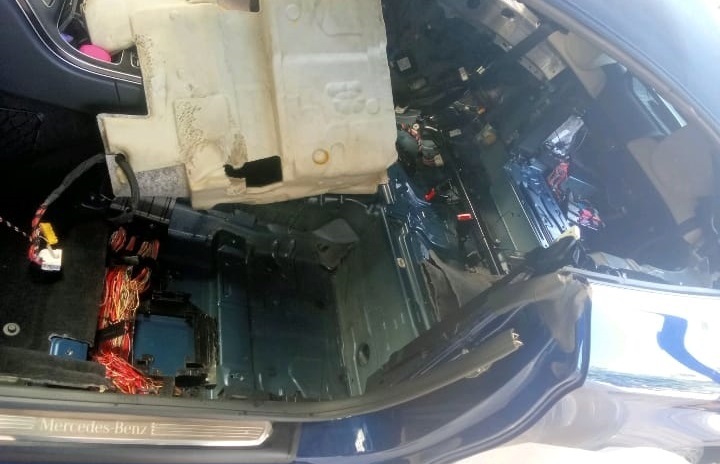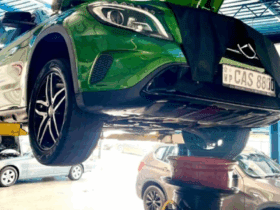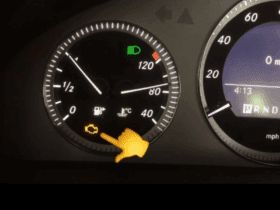Table of Contents
Convertible Roof Not Working: A Case Study in a Mercedes-Benz C300 Cabriolet (W205)
Vehicle: Mercedes-Benz C300 Cabriolet (W205)
Customer Complaint: Convertible Roof not Working
One of the most common complaints owners of convertible vehicles face is when the convertible roof stops working. Recently, I had a 2017 Mercedes-Benz C300 Cabriolet brought into my workshop with this very issue. The customer expressed concern that the convertible roof was not working, along with several other electrical problems.

Initial Inspection
Upon initial inspection, there were no obvious signs of wear or malfunction related to the mechanical parts of the convertible roof system. The hydraulic components and roof mechanism appeared intact, and the electrical controls on the dashboard responded intermittently. This led me to believe the issue lay deeper within the vehicle’s electrical system.
Diagnosing the Convertible Roof Issue
After carrying out a thorough diagnostic scan, I noticed communication errors within the vehicle’s control modules. As I delved further, it became apparent that this particular Mercedes-Benz C300 Cabriolet had been the victim of a rodent infestation. Several wiring harnesses had been damaged, causing intermittent failures in various systems, including the convertible roof.
Rodent Damage: The Culprit Behind the Convertible Roof Failure
Rodents are known to chew through electrical wiring in vehicles, especially in confined areas like the engine bay and wiring channels under the body panels. In this case, they had chewed through the body wiring harness in several places. This not only caused the convertible roof not to working, but also led to other electrical malfunctions.


- Damaged Wiring: Key wires controlling the convertible roof’s operation were severed.
- Control Module Disruptions: The roof system control module was intermittently losing power due to the damaged wiring, causing the roof to stop working.
- Other Problems: The rodent damage also caused malfunctions in the lighting system and parking sensors, further indicating the extent of the harm done to the wiring.


The Repair Process
Repairing the wiring harness was a meticulous process. Each damaged wire had to be carefully traced, repaired, and insulated. After hours of work, all connections were restored. Once this was completed, the convertible roof system began functioning properly again.

The Outcome
After the necessary repairs were carried out, including fixing the rodent damage, the convertible roof issue was resolved. The customer was able to enjoy their Mercedes-Benz C300 Cabriolet without any further problems. It’s worth noting that maintaining the vehicle’s environment is crucial to avoid similar issues.
I always advise my customers to keep their surroundings clean and inspect their vehicles regularly for signs of rodent activity.
Key Takeaways:
- Convertible Roof not Working in the Mercedes-Benz C300 Cabriolet (W205) can often be linked to electrical issues.
- Rodent damage is a surprisingly common cause of electrical failures in luxury vehicles.
- Regular inspections and maintaining a clean environment can help prevent these costly repairs.
Mercedes Convertible Roof Problems
Common Mercedes Convertible Roof Problems
Hydraulic System Failure
Many Mercedes convertible roofs, especially those with complex mechanisms, use hydraulic systems to operate. Over time, these systems can develop leaks or lose pressure, resulting in the roof not opening or closing properly. Signs include slow roof movement or failure to respond to commands.
Electrical Issues
The convertible roof system is heavily reliant on various sensors, control modules, and wiring. Any failure in these electrical components, such as a blown fuse, faulty switch, or damaged wiring (often caused by rodent damage), can prevent the roof from functioning. Diagnostic scans can often reveal communication errors between the roof module and the car’s control system.
Roof Motor Failure
The motor that drives the convertible roof mechanism can wear out over time. A common symptom is the roof being stuck midway or not moving at all. In such cases, the motor may need repair or replacement.
Latching Mechanism Problems
The latching mechanism that secures the roof in place when it’s fully closed can malfunction. If the roof is not able to latch properly, it could prevent the roof from closing fully or cause issues like air leaks or wind noise.
Sensor and Calibration Issues
The roof relies on various sensors to ensure it’s in the correct position during operation. If these sensors are misaligned or faulty, the roof can malfunction. Recalibrating the roof system or replacing faulty sensors is often necessary.
Worn Seals and Weatherstripping
Over time, the seals and weatherstripping around the convertible roof can wear out. This leads to water leaks, wind noise, and drafts, especially when driving at higher speeds. Regular maintenance of these seals is crucial to prevent damage.
Convertible Roof Switch Malfunction
The switch that controls the convertible roof can wear out or break. If the switch is not functioning, the roof may not respond to commands to open or close.
Roof Misalignment
Convertible roofs, especially hardtops, can become misaligned over time. This can cause the roof to not close properly or become stuck during operation. Re-aligning the roof mechanism may resolve this issue.
Convertible Roof Maintenance
Convertible Roof Maintenance is essential to ensure the smooth operation and longevity of the roof system, whether it’s a fabric soft top or a hardtop. Regular upkeep helps prevent malfunctions and expensive repairs. Here are some key maintenance tips:
1. Regular Cleaning
- Fabric Roofs: Clean the fabric soft top with products specifically designed for convertible roofs. Avoid using harsh chemicals that can degrade the material or its waterproofing properties. Use a soft brush to gently scrub dirt and grime off the surface.
- Hardtops: Clean hardtop surfaces like you would the rest of the vehicle, using a mild car shampoo and soft cloth. Don’t forget to clean the seals and trim as well.
- Windows: For rear plastic windows, use a non-abrasive cleaner to avoid scratching. Glass windows should be cleaned with glass cleaner for streak-free clarity.
2. Conditioning the Roof
- Fabric roofs need conditioning to maintain their water-repellent properties. Use a convertible top protectant spray to help the fabric stay resistant to rain and UV rays, which can fade or damage the fabric over time.
- Conditioning the fabric also helps it remain soft and pliable, reducing the risk of cracking.
3. Lubricating Moving Parts
- The hinges, joints, and other moving parts of the convertible roof mechanism should be lubricated regularly. Use a silicone-based lubricant to keep the parts moving smoothly and prevent squeaks or resistance during operation.
- Avoid using heavy oils or grease as they can attract dirt and grime, which may cause the parts to wear faster.
4. Inspecting Seals and Weatherstripping
- The rubber seals around the convertible roof and windows play a critical role in keeping water and wind out. Inspect these seals regularly for signs of cracking, wear, or displacement.
- Apply a rubber seal protectant to keep them soft and pliable. If any seals appear damaged or excessively worn, they should be replaced immediately to prevent leaks and wind noise.
5. Check Hydraulic System
- For roofs operated by a hydraulic system, check the hydraulic fluid levels regularly. Low hydraulic fluid can lead to slow or failed roof operation.
- Inspect for any signs of fluid leaks around the hydraulic lines or roof actuators. If you notice leaks or the roof is operating slowly, it may indicate a need for fluid top-up or system servicing.
6. Inspect the Roof Mechanism
- Regularly check the roof’s motor and latching mechanism for signs of wear or malfunction. If the motor seems weak, slow, or unresponsive, it may need repair or replacement.
- Listen for any unusual noises like grinding or clicking during operation, which could indicate alignment issues or mechanical wear.
7. Ensure Proper Roof Operation
- Always follow the manufacturer’s instructions for operating the roof. Ensure that the vehicle is stationary and in the proper conditions (like not moving above a certain speed) before opening or closing the roof.
- Don’t force the roof open or closed if it seems stuck—this could lead to significant mechanical damage.
8. Avoid Harsh Weather Exposure
- Avoid leaving your convertible roof exposed to harsh weather for extended periods. Prolonged exposure to the sun can fade the fabric or cause seals to dry out, while snow or heavy rain can lead to water damage or stress on the roof structure.
- When possible, store the vehicle in a garage or under a car cover to protect it from the elements.
9. Check Electrical Components
- For electrically operated roofs, inspect the wiring, switches, and control modules for signs of damage or wear. Faulty electrical components can cause intermittent or complete roof failure.
- If the roof is not responding to commands or behaving inconsistently, have the electrical system checked by a professional technician.
10. Store the Vehicle Properly
- If you’re storing your convertible for long periods (such as during winter), it’s important to raise the roof before storage. Storing a vehicle with the roof down for extended periods can cause the fabric to stretch or lose shape.
- Also, store the vehicle in a clean and dry area to avoid potential rodent damage to the roof or wiring.
Convertible Roof Maintenance Best Practices Summary:
- Clean the roof regularly using appropriate products for fabric or hardtop.
- Lubricate the roof’s moving parts to prevent wear and ensure smooth operation.
- Inspect seals, weatherstripping, and the hydraulic system to catch early signs of damage or wear.
- Protect the roof from extreme weather and ensure proper storage conditions.
- Follow proper operational guidelines to prevent damage during use.
By adhering to these maintenance tips, you can extend the lifespan of your convertible roof and avoid common problems like roof leaks, mechanism failures, or malfunctions.






Leave a Reply